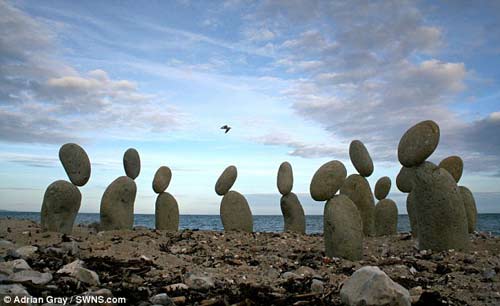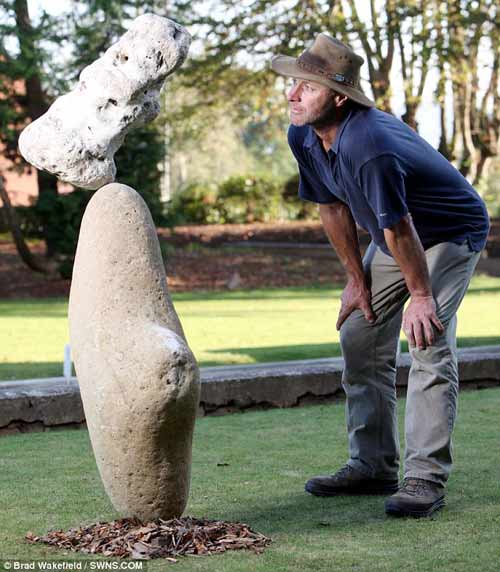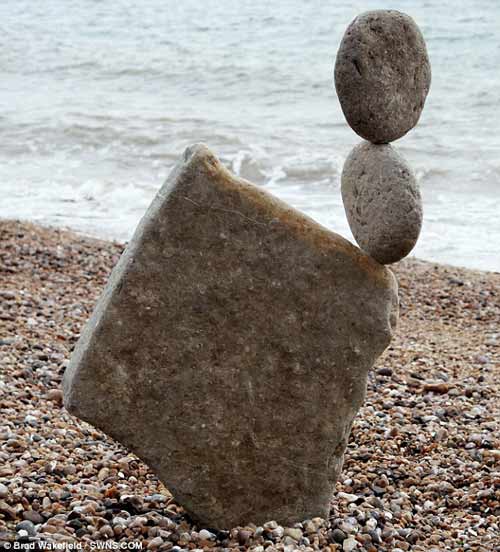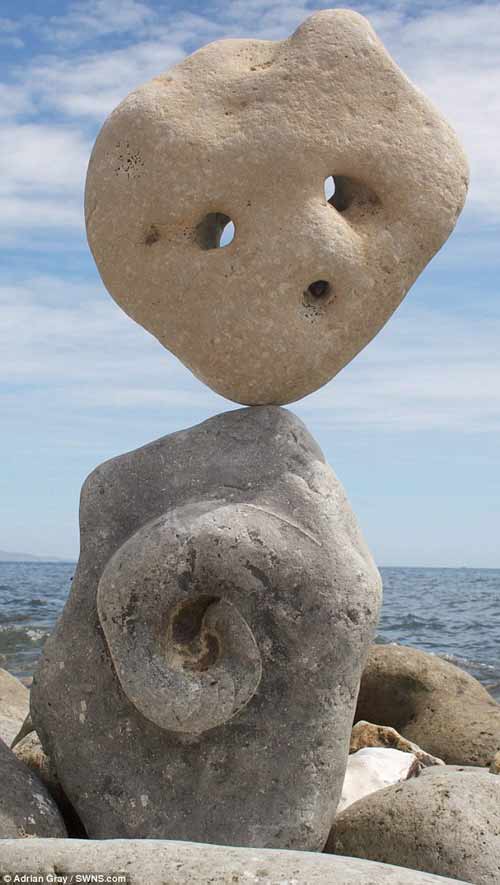MailOnline
Putting a rock in a hard place:
Sculptures that require just short of amazing balancing act
These gravity-defying sculptures were created without glue or pins - just painstakingly balanced on one another.
Patient artist Adrian Gray, 44, spends hours scouring a nearby beach to select the ideal-sized rocks, boulders and pebbles to fit with each other.
Adrian then arranges them in precarious positions by very carefully 'feeling' the balancing point of each rock - a process that requires supreme skill.
Each sculpture takes hours to perfect, but he has now created dozens of stunning 'installations' that amaze beachgoers by appearing in a seemingly impossible structure.
Adrian's obsession with stone balancing began nine years ago when, as an adventure holiday tour guide, he caught a tropical virus while exploring in Madagascar.
He eventually got over the infection but it left him with some unusual side-affects, including a sensitive allergy to electricity.
Adrian, of Lyme Regis, Dorset, said: 'I started creating stonebalancing sculptures in 2002. I was spending a lot of time recuperating on the local beaches looking for inspiration.
'I had recently given up leading overseas expeditions after picking up a nasty virus in Madagascar.
'I had a lot of time on my hands and, it was during this difficult time that I immersed myself in my art and concentrated on creating improbable and beautiful stone balancing sculptures.
'The process of balancing the stones had an almost meditative quality, both calming and therapeutic.
'When I started, people would tell me the sculptures had a strange 'presence'.
'There is a paradox between the fragility of balancing against the solidity of the hulking great stones.'
Bachelor Adrian developed his unusual technique after coming to terms with a devastating tropical illness in 2002 while running a backpack tour company for would-be adventurers.
Although cured of the tropical bug, he succumbed to post-viral ME and became, he admits, pretty much allergic to modern life.
Electricity, TV, laptops, even mobile phones brought on headaches, nausea and mood changes.
The condition left him sensitive to electricity and he does not own a phone, television or computer, though he does have a woodburning stove and a gas supply that enables him to boil a kettle.
'If people disbelieve what they are seeing, it means I have achieved my aim of creating art that has a sense of wonder and magic'
Adrian added: 'This evolved into post-viral ME and then a sensitivity to all things electrical and chemical.
'I gave up my mobile, television, computer, fridge, car, lighting and moved into a yurt, where I lived for nine months until I found my present house, which has no electricity or mobile phone signal.'
He found solace in his calming artwork and now makes a living selling posters of his artwork, scours pebble beaches searching for the ideal pebbles and stones to use in his sculptures.
He balances them before literally holding them in place with his body, creating a series of stunning gravity-defying pieces.
In order to avoid them toppling on beach goers, he dismantles them after taking a picture for his gallery, which now includes photographs of dozens of incredible sculptures.
Adrian, who lives in a one-room limestone house carved out of the cliffside above the beach, added: 'I spend a lot of time looking for rocks which will make an interesting composition.
'On the local beaches there is a huge selection and when I have found two that have the right qualities I experiment until I find the place where they will perch at a seemingly impossible angle on the smallest point of contact.
'For everyone, the reaction and the experience is different. For many, it is the unexplained natural beauty of the sculpture that mesmerises.'
But not everyone believes his art is genuine, with people previously accusing him of using Blu Tack or even glue to hold the stones in place.
'If people disbelieve what they are seeing, it means I have achieved my aim of creating art that has a sense of wonder and magic, which I think a lot of contemporary art nowadays is lacking.'
|

 Sculpture News at SculptSite.com
Sculpture News at SculptSite.com





